3D FEM Simulation and Analysis of Fractal Electrode-Based FBAR Resonator for Tetrachloroethene (PCE) Gas Detection
Abstract
:1. Introduction
2. Materials and Methods
Gas Sensing Mechanism
3. Results
3.1. Convergence Study
3.2. Optimization of Parameter
3.2.1. Optimization of Hilbert Fractal Gap
3.2.2. Effect of Polyisobutylene Layer (PIB) Thickness Variation
3.2.3. Effect of FBAR Area Variation
3.2.4. Effect of Gas Exposure on the Parameters
4. Discussion
5. Conclusions
Author Contributions
Funding
Data Availability Statement
Acknowledgments
Conflicts of Interest
References
- Awang, Z. Gas sensors: A review. Sens. Transducers 2014, 168, 61–75. [Google Scholar]
- Fu, Y.Q.; Cherng, J.S.; Luo, J.K.; Desmulliez, M.P.Y.; Li, Y.; Walton, A.J.; Placido, F. Aluminium Nitride Thin Film Acoustic Wave Device for Microfluidic and Biosensing Applications. Acoustic Waves. 2010, 466. [Google Scholar]
- Chiu, K.-H.; Chen, H.-R.; Huang, S.R.-S. High-performance film bulk acoustic wave pressure and temperature sensors. Jpn. J. Appl. Phys. 2007, 46, 1392. [Google Scholar] [CrossRef]
- Qiu, X.; Zhu, J.; Oiler, J.; Yu, C.; Wang, Z.; Yu, H. Film bulk acoustic-wave resonator based ultraviolet sensor. Appl. Phys. Lett. 2009, 94, 151917. [Google Scholar] [CrossRef]
- Zhao, X.; Zhao, Z.; Wang, B.; Qian, Z.; Ma, T. The Design of a Frame-Like ZnO FBAR Sensor for Achieving Uniform Mass Sensitivity Distributions. Sensors 2020, 20, 2408. [Google Scholar] [CrossRef] [PubMed]
- Xuan, W.; Cole, M.; Gardner, J.W.; Thomas, S.; Villa-López, F.-H.; Wang, X.; Dong, S.; Luo, J. A film bulk acoustic resonator oscillator based humidity sensor with graphene oxide as the sensitive layer. J. Micromech. Microeng. 2017, 27, 055017. [Google Scholar] [CrossRef]
- Zhang, M.; Du, L.; Fang, Z.; Zhao, Z. A sensitivity-enhanced film bulk acoustic resonator gas sensor with an oscillator circuit and its detection application. Micromachines 2017, 8, 25. [Google Scholar] [CrossRef]
- Chen, Y.-C.; Shih, W.-C.; Chang, W.-T.; Yang, C.-H.; Kao, K.-S.; Cheng, C.-C. Biosensor for human IgE detection using shear-mode FBAR devices. Nanoscale Res. Lett. 2015, 10, 69. [Google Scholar] [CrossRef]
- Wu, Y.; Dong, S.; Jin, H.; Wang, X.; Chen, G. Flexible magnetic sensor based on FBAR. In Proceedings of the 2016 IEEE International Nanoelectronics Conference (INEC), Chengdu, China, 9–11 May 2016. [Google Scholar]
- Howe, E.; Harding, G. A comparison of protocols for the optimisation of detection of bacteria using a surface acoustic wave (SAW) biosensor. Biosens. Bioelectron. 2000, 15, 641–649. [Google Scholar] [CrossRef]
- Buff, W.; Klett, S.; Rusko, M.; Ehrenpfordt, J.; Goroli, M. Passive remote sensing for temperature and pressure using SAW resonator devices. IEEE Trans. Ultrason. Ferroelectr. Freq. Control. 1998, 45, 1388–1392. [Google Scholar] [CrossRef]
- Kittmann, A.; Müller, C.; Durdaut, P.; Thormählen, L.; Schell, V.; Niekiel, F.; Lofink, F.; Meyners, D.; Knöchel, R.; Höft, M.; et al. Sensitivity and noise analysis of SAW magnetic field sensors with varied magnetostrictive layer thicknesses. Sens. Actuators A Phys. 2020, 311, 111998. [Google Scholar] [CrossRef]
- Chivukula, V.; Ciplys, D.; Shur, M.; Dutta, P. ZnO nanoparticle surface acoustic wave UV sensor. Appl. Phys. Lett. 2010, 96, 233512. [Google Scholar] [CrossRef]
- Lee, Y.; Kim, H.; Roh, Y.; Cho, H.; Baik, S. Development of a SAW gas sensor for monitoring SO2 gas. Sens. Actuators A Phys. 1998, 64, 173–178. [Google Scholar] [CrossRef]
- Wu, T.-T.; Chen, Y.-Y.; Chou, T.-H. A high sensitivity nanomaterial based SAW humidity sensor. J. Phys. D Appl. Phys. 2008, 41, 085101. [Google Scholar] [CrossRef]
- Colon-Berrios, A.R.; Edrees, H.; McGinn, C.; Cavallari, M.R.; Kinget, P.; Kymissis, I. CMOS integrated ZnO thin film bulk acoustic resonator with Si3N4 susceptor layer for improved IR sensitivity. In Proceedings of the 2017 75th Annual Device Research Conference (DRC), IEEE, South Bend, IN, USA, 25–28 June 2017. [Google Scholar]
- Yan, X.; Qu, H.; Chang, Y.; Pang, W.; Duan, X. A prototype portable instrument employing micro-preconcentrator and FBAR sensor for the detection of chemical warfare agents. Nanotechnol. Precis. Eng. 2022, 5, 013005. [Google Scholar] [CrossRef]
- Campanella Pineda, H. Thin-Film Bulk Acoustic Wave Resonators-FBAR: Fabrication, Heterogeneous Integration with CMOS Technologies and Sensor Applications. Ph.D. Thesis, Universitat Autònoma de Barcelona, Bellaterra, Spain, 2008. Available online: https://www.tdx.cat/handle/10803/5357 (accessed on 23 July 2022).
- Hesari, N.; Francis, C.M.; Halden, R.U. Evaluation of glycol ether as an alternative to perchloroethylene in dry cleaning. Toxics 2014, 2, 115–133. [Google Scholar] [CrossRef]
- Guyton, K.Z.; Hogan, K.A.; Scott, C.S.; Cooper, G.S.; Bale, A.S.; Kopylev, L.; Barone, S.; Makris, S.L.; Glenn, B.; Subramaniam, R.P.; et al. Human health effects of tetrachloroethylene: Key findings and scientific issues. Environ. Health Perspect. 2014, 122, 325–334. [Google Scholar] [CrossRef]
- Modenese, A.; Gioia, T.C.; Chiesi, A.; Abbacchini, C.; Borsari, L.; Ferrari, D.; De Pasquale, F.; Di Rico, R.; Ricci, R.; Sala, A.; et al. Evaluation of occupational exposure to perchlorethylene in a group of Italian dry cleaners using noninvasive exposure indices. Int. J. Environ. Res. Public Health 2019, 16, 2832. [Google Scholar] [CrossRef]
- Aschengrau, A.; Winter, M.R.; Gallagher, L.G.; Vieira, V.M.; Butler, L.J.; Fabian, M.P.; Carwile, J.L.; Wesselink, A.K.; Mahalingaiah, S.; Janulewicz, P.A.; et al. Reproductive and developmental health effects of prenatal exposure to tetrachloroethylene-contaminated drinking water. Environ. Sci. Processes Impacts 2020, 22, 555–566. [Google Scholar] [CrossRef]
- Ho, C.K.; Lindgren, E.R.; Rawlinson, K.S.; McGrath, L.K.; Wright, J.L. Development of a surface acoustic wave sensor for in-situ monitoring of volatile organic compounds. Sensors 2003, 3, 236–247. [Google Scholar] [CrossRef]
- Zeng, G.; Wu, C.; Chang, Y.; Zhou, C.; Chen, B.; Zhang, M.; Li, J.; Duan, X.; Yang, Q.; Pang, W. Detection and discrimination of volatile organic compounds using a single film bulk acoustic wave resonator with temperature modulation as a multiparameter virtual sensor array. ACS Sens. 2019, 4, 1524–1533. [Google Scholar] [CrossRef]
- Potyrailo, R.A.; May, R.J.; Sivavec, T.M. Recognition and quantitation of closely related chlorinated organic vapors with acoustic-wave chemical sensor arrays. Intern. Stand. Calibration Archit. Chem. Sens. SPIE 1999, 3856, 80–87. [Google Scholar]
- Poplavko, Y.M.; Yakimenko, Y. Functional Dielectrics for Electronics: Fundamentals of Conversion Properties; Woodhead Publishing: Sawston Cambridge, UK, 2020. [Google Scholar]
- Bhadauria, A.; Panchal, B.; Varghese, S. Enhancing Q-factor using fractal electrodes in Film Bulk Acoustic Resonator for wireless applications. In Proceedings of the IEEE 2016 Asia-Pacific Microwave Conference (APMC), New Delhi, India, 5–9 December 2016. [Google Scholar]
- Grate, J.W.; Patrash, S.J.; Abraham, M.H. Abraham. Method for estimating polymer-coated acoustic wave vapor sensor responses. Anal. Chem. 1995, 67, 2162–2169. [Google Scholar] [CrossRef]
- Ralib, A.A.; Omar, A.S.S. An Investigation of The Sensitivity Of Polymer-Coated Surface Acoustic Wave-Based Gas Sensors In The Detection Of Volatile Organic Compounds. IIUM Eng. J. 2021, 22, 168–177. [Google Scholar] [CrossRef]
- Sayago, I.; Fernández, M.; Fontecha, J.; Horrillo, M.; Vera, C.; Obieta, I.; Bustero, I. Surface acoustic wave gas sensors based on polyisobutylene and carbon nanotube composites. Sens. Actuators B Chem. 2011, 156, 1–5. [Google Scholar] [CrossRef]
- COMSOL Multiphysics. Available online: https://www.comsol.com/support/knowledgebase/875 (accessed on 16 August 2022).
- COMSOL Multiphysics. Available online: https://www.comsol.com/blogs/much-memory-needed-solve-large-comsol-models/ (accessed on 16 August 2022).
- Liu, C.-Y.; Deb, M.; Sadhu, A.S.; Karmakar, R.; Huang, P.-T.; Lin, Y.-N.; Chu, C.-S.; Pal, B.N.; Chang, S.-H.; Biring, S. Resolving cross-sensitivity effect in fluorescence quenching for simultaneously sensing oxygen and ammonia concentrations by an optical dual gas sensor. Sensors 2021, 21, 6940. [Google Scholar] [CrossRef]
- Kim, K.; Lee, T.H.; Kang, D.H.; Kwon, H.B.; Lee, S.M.; Yoo, S.J.; Hong, U.S.; Kim, Y.J. Ammonia Cross-Sensitivity Eliminatin Method of NOx Sensor for UREA-SCR (Selective Catalytic Reduction) System. In Proceedings of the 20th International Conference on Solid-State Sensors, Actuators and Microsystems & Eurosensors XXXIII (TRANSDUCERS & EUROSENSORS XXXIII), IEEE, Berlin, Germany, 23–27 June 2019. [Google Scholar]
- Hsieh, M.F.; Wang, J. An extended Kalman filter for NO x sensor ammonia cross-sensitivity elimination in selective catalytic reduction applications. In Proceedings of the 2010 American Control Conference, IEEE, Baltimore, MD, USA, 30 June–2 July 2010. [Google Scholar]
- Hong, H.S.; Kim, J.W.; Jung, S.J.; Park, C.O. Suppression of NO and SO2 cross-sensitivity in electrochemical CO2 sensors with filter layers. Sens. Actuators B Chem. 2006, 113, 71–79. [Google Scholar] [CrossRef]
- Chen, D.; Yang, L.; Yu, W.; Wu, M.; Wang, W.; Wang, H. Micro-electromechanical acoustic resonator coated with polyethyleneimine nanofibers for the detection of formaldehyde vapor. Micromachines 2018, 9, 62. [Google Scholar] [CrossRef]
- Penza, M.; Aversa, P.; Cassano, G.; Suriano, D.; Wlodarski, W.; Benetti, M.; Cannata, D.; Di Pietrantonio, F.; Verona, E. Thin-film bulk-acoustic-resonator gas sensor functionalized with a nanocomposite Langmuir–Blodgett layer of carbon nanotubes. IEEE Trans. Electron Devices 2008, 55, 1237–1243. [Google Scholar] [CrossRef]
- Xu, S.; Zhang, R.; Cui, J.; Liu, T.; Sui, X.; Han, M.; Zheng, F.; Hu, X. Surface Acoustic Wave DMMP Gas Sensor with a Porous Graphene/PVDF Molecularly Imprinted Sensing Membrane. Micromachines 2021, 12, 552. [Google Scholar] [CrossRef]
- Lee, S.; Lee, J. Gas-Phase Nitroaromatic Detection Based on Sulfonated Tetrafluoroethylene and Its Field Application. Sens. Mater. 2014, 26, 753–762. [Google Scholar]
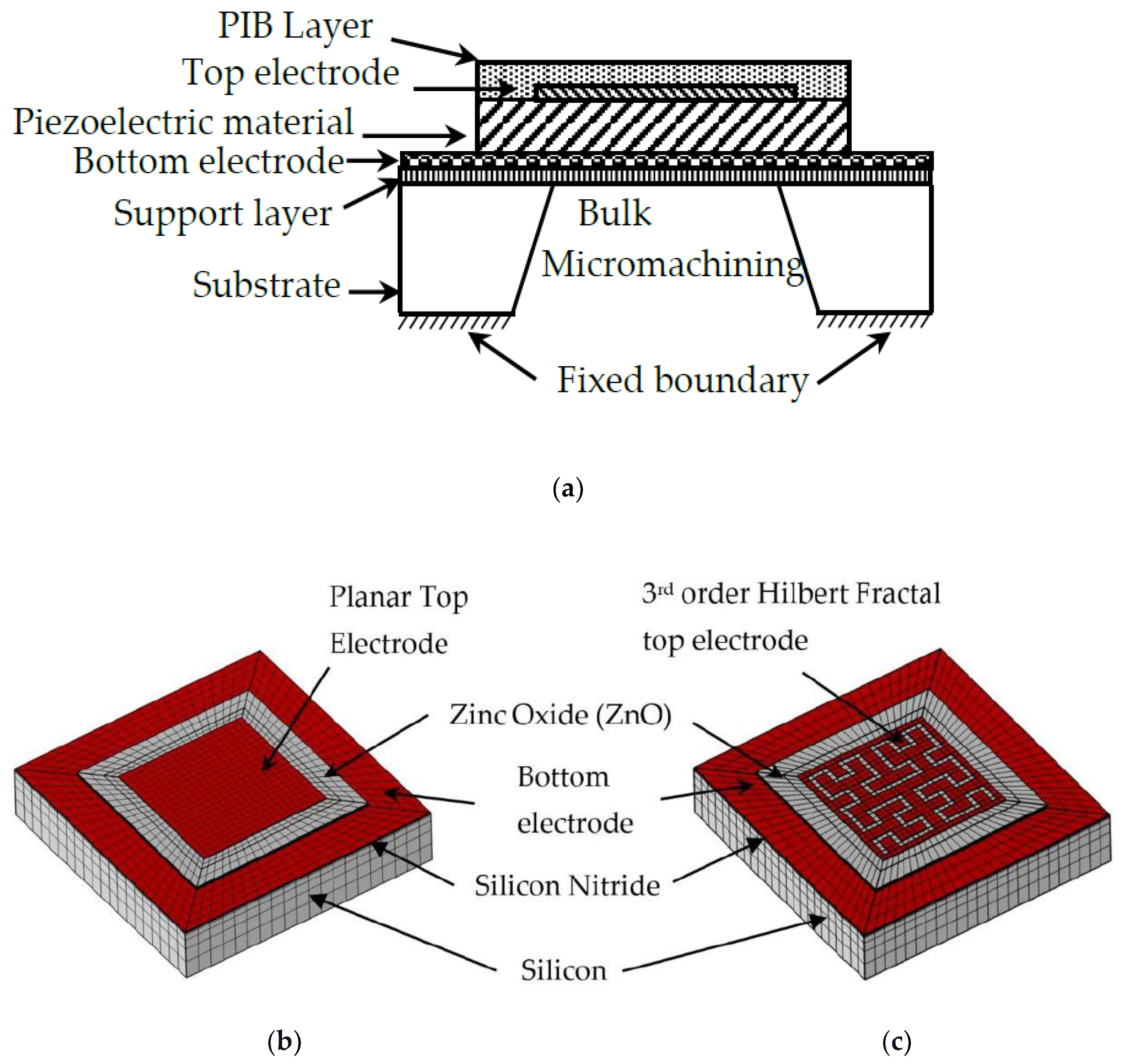

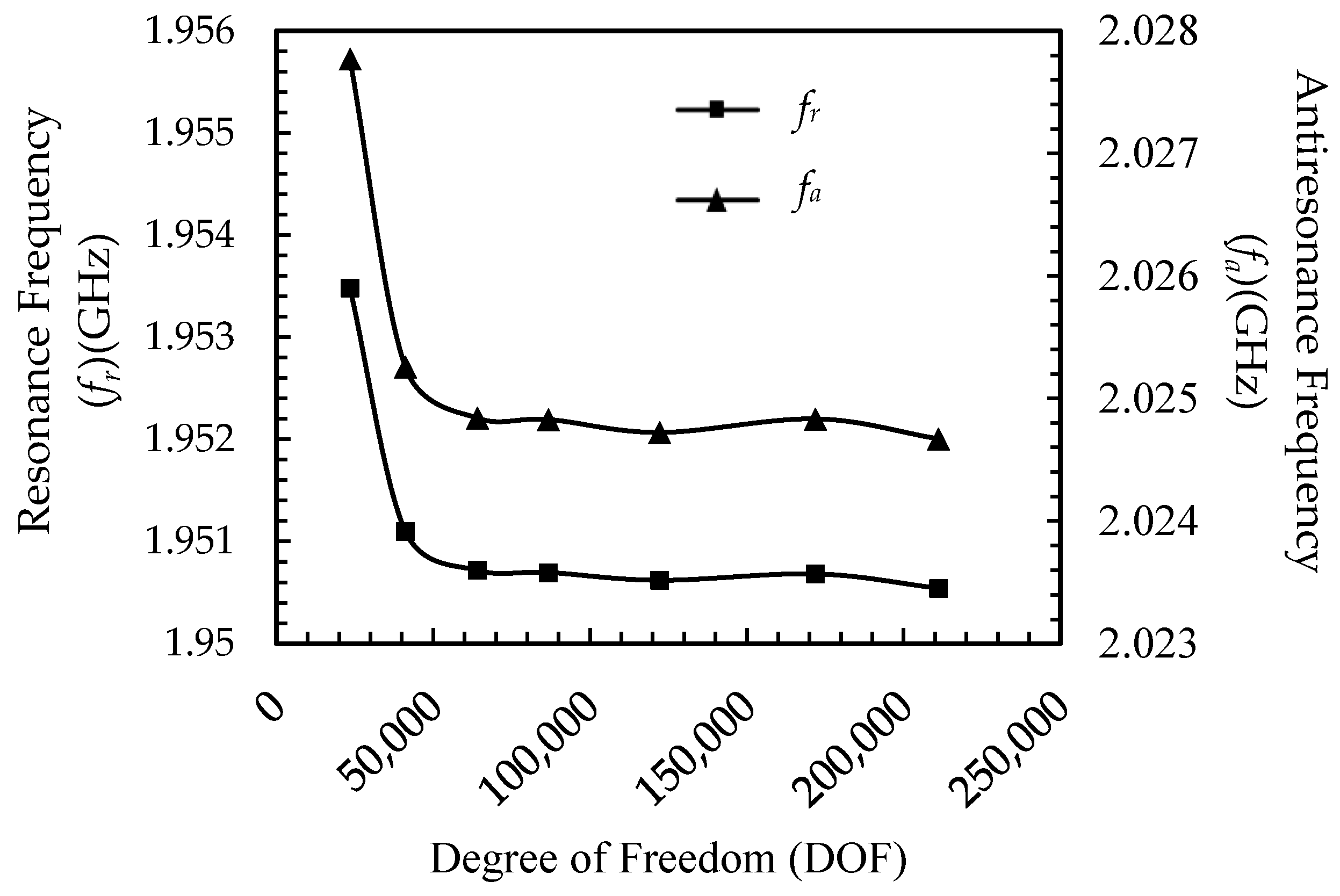

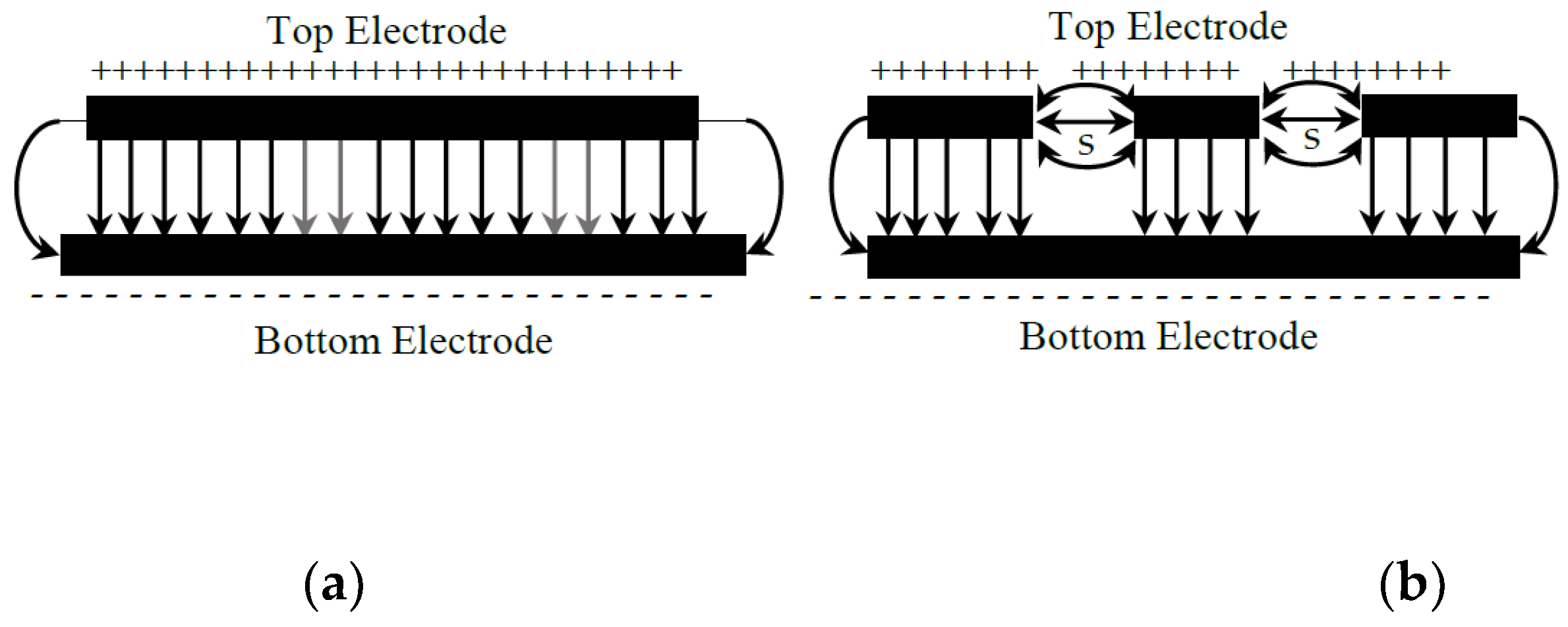
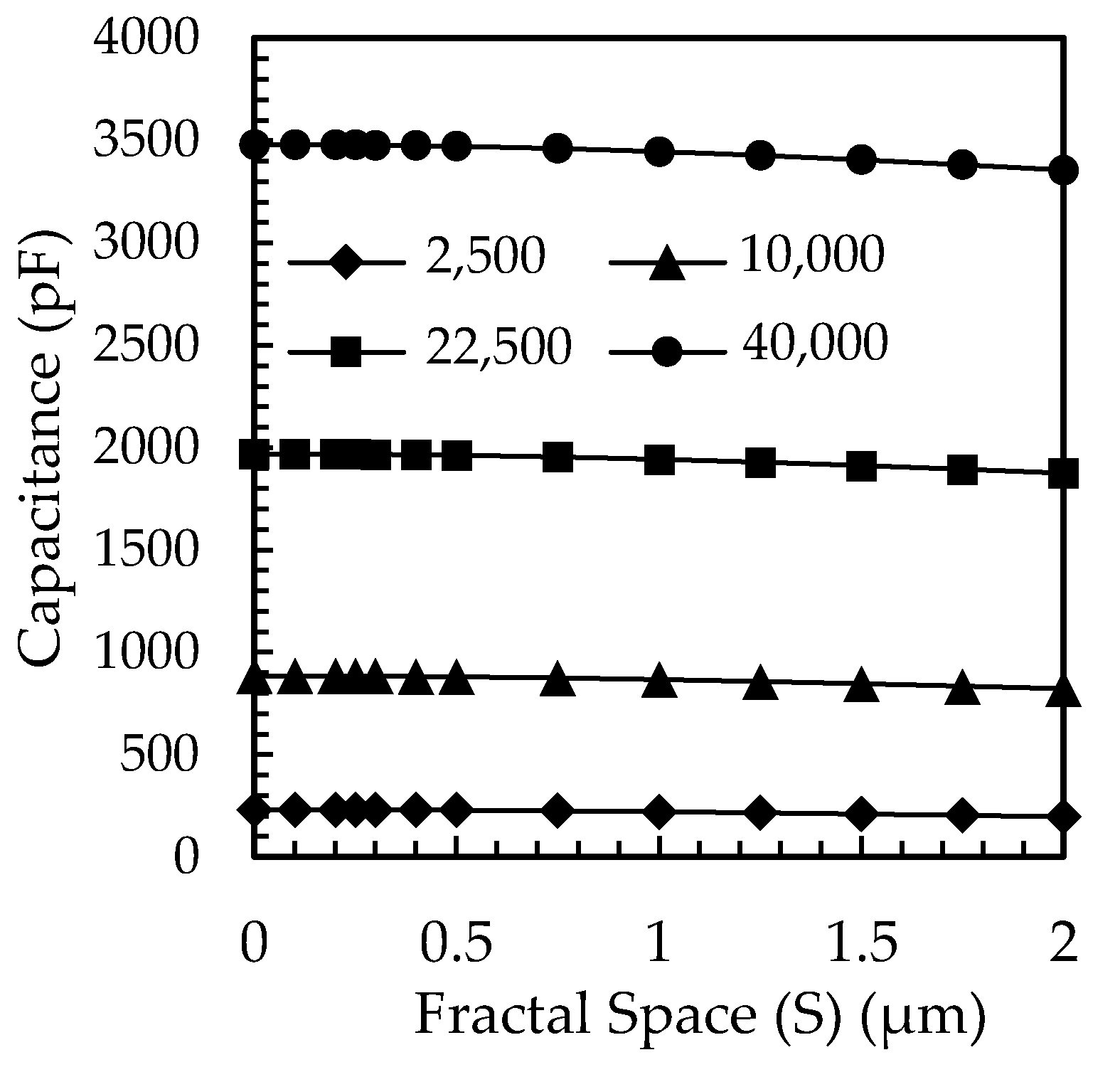

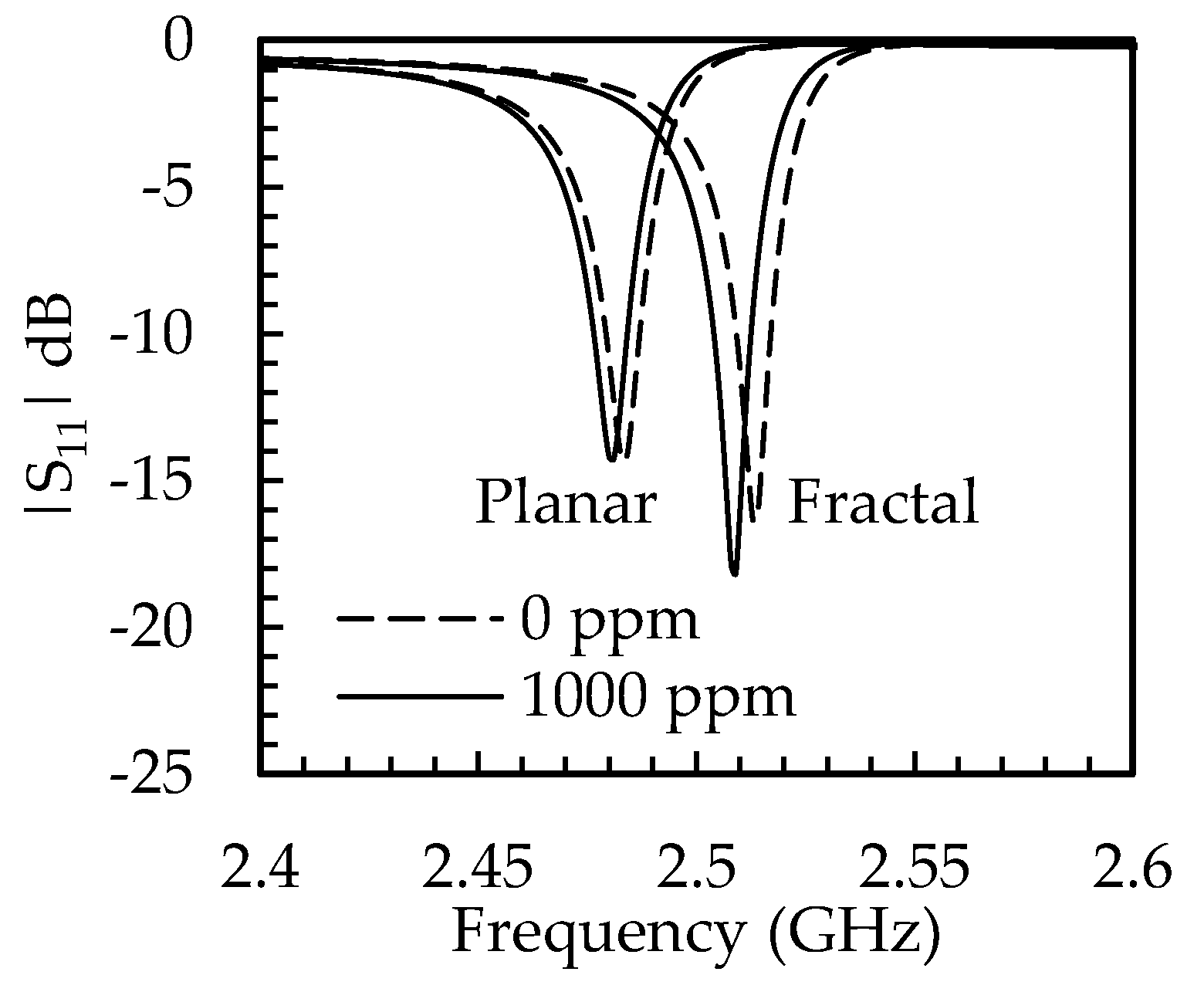
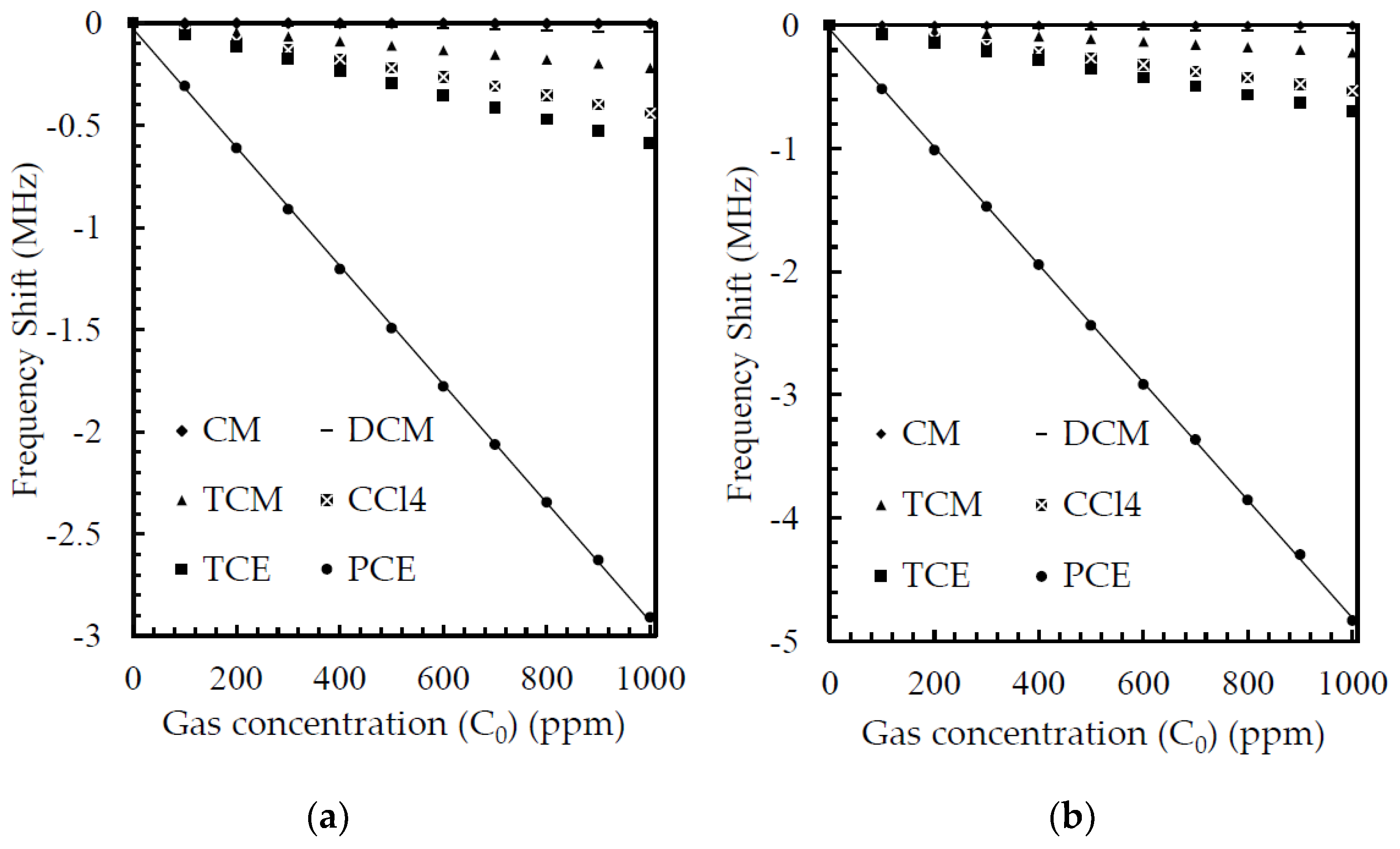
| Parameter | Value for PIB |
|---|---|
| Relative permittivity of PIB | 2.2 |
| Density (kg/m3) | 918 |
| Young modulus (GPa) | 10 |
| Poisson’s Ratio of PIB | 0.48 |
| Gas | Partition Coefficient (k) for PIB/Gas | Molar Mass of Gas (g/mol) |
|---|---|---|
| CM | 3.57 | 50.4 |
| DCM | 30.34 | 85.0 |
| TCM | 84.58 | 119.5 |
| CCl4 | 160.69 | 153.8 |
| TCE | 250.84 | 131.4 |
| PCE | 954.77 | 165.83 |
| Fractal Spacing S (µm) | Frequencies | Quality Factors | Coupling Coefficient (%) | ||
|---|---|---|---|---|---|
| fr (GHz) | fa (GHz) | Qr | Qa | ||
| 0.1 | 1.952 | 2.030 | 280.042 | 274.637 | 9.12 |
| 0.2 | 1.954 | 2.032 | 278.446 | 274.486 | 9.11 |
| 0.3 | 1.956 | 2.034 | 294.282 | 288.436 | 9.10 |
| 0.4 | 1.958 | 2.038 | 298.014 | 304.375 | 9.31 |
| 0.5 | 1.96 | 2.038 | 305.834 | 301.802 | 9.08 |
| 0.6 | 1.96 | 2.038 | 322.804 | 309.940 | 9.08 |
| 0.7 | 1.96 | 2.044 | 328.194 | 325.952 | 9.72 |
| 0.8 | 1.956 | 2.064 | 344.206 | 310.519 | 12.24 |
| 0.9 | 1.972 | 2.060 | 342.295 | 316.401 | 10.09 |
| 1.0 | 1.976 | 2.059 | 348.082 | 325.279 | 9.55 |
| 1.1 | 1.984 | 2.066 | 329.847 | 311.569 | 9.40 |
| 1.2 | 1.986 | 2.062 | 317.600 | 310.992 | 8.76 |
| 1.3 | 1.988 | 2.066 | 319.286 | 312.468 | 8.96 |
| 1.4 | 1.99 | 2.066 | 322.459 | 311.097 | 8.74 |
| 1.5 | 1.992 | 2.068 | 329.048 | 317.460 | 8.73 |
| Gas Exposure | Sensitivity (S) (kHz/ppm) | |
|---|---|---|
| Planar | Fractal | |
| CM | 0.003 | 0.004 |
| DCM | 0.046 | 0.057 |
| TCM | 0.181 | 0.220 |
| CCl4 | 0.442 | 0.529 |
| TCE | 0.589 | 0.700 |
| PCE | 2.909 | 4.833 |
| Type | Gas Concentration (ppm) | Rm (Ohm) | Lm (µH) | Cm (fF) | C0 (pF) |
|---|---|---|---|---|---|
| Planar | 0 | 23.47 | 0.686 | 5.984 | 0.201 |
| 1000 | 23.64 | 0.688 | 5.975 | 0.201 | |
| Fractal | 0 | 14.36 | 0.705 | 5.683 | 0.192 |
| 1000 | 13.63 | 0.662 | 6.079 | 0.192 |
| Reference | Volatile Organic Compound (VOC) Gas | Type of Device | Resonance Frequency (fr) | Sensitivity (S) |
|---|---|---|---|---|
| Present Work | Tetrachloroethene (PCE) | FBAR | 2.5 GHz | 4.833 kHz/ppm |
| [37] | Formaldehyde | FBAR | 4.4 GHz | 1.216 kHz/ppb |
| [38] | Acetone | FBAR | 1.045 GHz | 12 kHz/ppm |
| [38] | Ethylacetate | FBAR | 1.045 GHz | 17.3 kHz/ppm |
| [39] | Dimethyl methyl phosphonate (DMMP) | SAW delay line | 433 MHz | 1.407 kHz/ppm |
| [40] | 2,4-dinitrotoluene (DNT) | QCM | 5 MHz | 33.52 Hz/ppb |
Publisher’s Note: MDPI stays neutral with regard to jurisdictional claims in published maps and institutional affiliations. |
© 2022 by the authors. Licensee MDPI, Basel, Switzerland. This article is an open access article distributed under the terms and conditions of the Creative Commons Attribution (CC BY) license (https://creativecommons.org/licenses/by/4.0/).
Share and Cite
Panchal, B.; Bhadauria, A.; Varghese, S. 3D FEM Simulation and Analysis of Fractal Electrode-Based FBAR Resonator for Tetrachloroethene (PCE) Gas Detection. Fractal Fract. 2022, 6, 491. https://doi.org/10.3390/fractalfract6090491
Panchal B, Bhadauria A, Varghese S. 3D FEM Simulation and Analysis of Fractal Electrode-Based FBAR Resonator for Tetrachloroethene (PCE) Gas Detection. Fractal and Fractional. 2022; 6(9):491. https://doi.org/10.3390/fractalfract6090491
Chicago/Turabian StylePanchal, Bhargav, Avanish Bhadauria, and Soney Varghese. 2022. "3D FEM Simulation and Analysis of Fractal Electrode-Based FBAR Resonator for Tetrachloroethene (PCE) Gas Detection" Fractal and Fractional 6, no. 9: 491. https://doi.org/10.3390/fractalfract6090491
APA StylePanchal, B., Bhadauria, A., & Varghese, S. (2022). 3D FEM Simulation and Analysis of Fractal Electrode-Based FBAR Resonator for Tetrachloroethene (PCE) Gas Detection. Fractal and Fractional, 6(9), 491. https://doi.org/10.3390/fractalfract6090491






